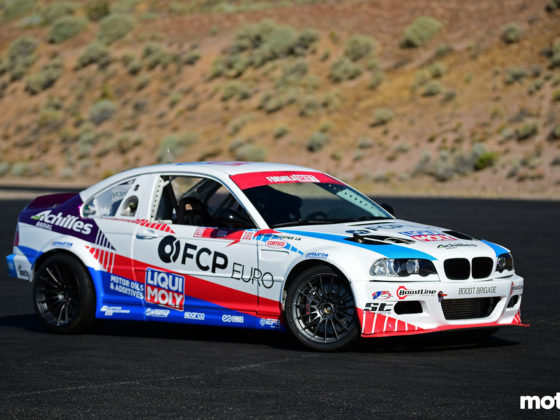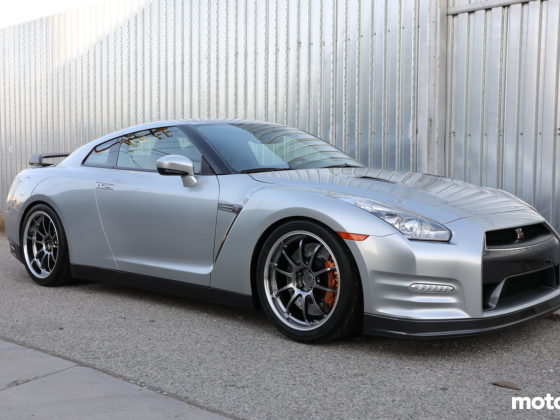Setting toe on your own is another job that requires a movement – climbing under the car to make an adjustment, then out from under the car to check the measurements. With a string setup you require a line that is fine and it must be pulled tight. For photo effectiveness we have used some thick red wool – what you don’t see between the wool and the car is some fishing line. The next time around we are going to try some kite string that we hope is fine enough for measuring yet thick enough to be easily seen. Fortunately, Jeremy popped over and our toe adjustments were much easier. There’s no question, two people or a hoist will really help with this entire process.

As mentioned already, the TurboFX rear control arms allow for easy adjustment of the camber and toe. Adjusting one or the other would get the amount of toe that you wanted. Here the ABS slider plates (we will sell them to you for $49.99 each plus shipping) were awesome and as they were left over from another project they were free. Shouldn’t be more than a few bucks at your local plastics’ store. They allowed the wheel to slip easily while the adjustments were made – even better is that we got the ABS at our favourite trailer shop, Cottonwood RV in Chilliwack, for just a few bucks. Of course, it helps that Kyle works there, but ABS is reasonably priced and easy to cut with a jigsaw (use a course blade with a low tooth count as a fine tooth blade will heat up the ABS and it will weld itself back together). Once the rear toe was done it was now time to check the camber again. The adjustments being used affect both camber and toe, so you may need to adjust both again to maintain the specifications that you want. In our case, we gained a tenth of a degree more negative camber. We were happy with that so now tightened everything up. Then used a paint pen to mark the nuts so it would be easy to see if they loosened with use.

Adjusting the front toe on the Nissan was also an easy and relatively straight-forward affair. The 2J-Racing tie rod ends are brand new so nothing was seized. The inner tie rods were in great shape and not new – and obviously as some point in history channel locks rather than wrenches had been used for adjustment as they were a bit chewed up. The inner tie rod should have a hex shape for adjustment somewhere near the middle – so use the proper tool. Without shortening the inner tie rods we mentioned in the DIY Aero article that we had huge toe in; and we still needed to cut off a bit more of the passenger side inner tie rod to get the adjustment room required. Once that room was gained, it was easy to get the toe we wanted. Confirming that the camber hadn’t been altered, we tightened everything up and applied our paint pen marks.
This wraps up our story of our DIY Alignment. We spent a bit of money to make it as simple and foolproof as possible. This is not a DIY manual to follow for your own alignment. If you aren’t sure, then go to a shop. But if you’re sure that your shop is not doing what you want, then it may be time.






6 comments
Great write-up. As always Mr. Ewald, your articles are informative and entertaining. I do have a question regarding the digital camber/caster tool: Is there a way to zero the measurement? You can zero a scale with nothing on it (or zero it with an empty container on it). How do you ensure that the -3.25 degrees of negative camber as measured by the tool is actually -3.25 degrees?
Banfstc, thank you. I appreciate your kind words.
Great question about the Longacre unit. It is supposed to hold it’s zero, even when shut off. According to AES, running my car on the Mustang dyno was like running one of his drift client cars – it didn’t want to run nicely for him. So I’m pretty sure the -ve camber is there. More details about the Longacre calibration can be found here: http://www.longacreracing.com/instructions.aspx?item=42369&article=AccuLevel%E2%84%A2%20%20Pro%20Model%20Digital%20Level%20(ver.%205)
It also has a calibration procedure if you’re in doubt that zero is zero.
In other words, you have to believe! Another reason to select a good name like Longacre.
Thank you so much for this article. I read Erik’s article when it first came out and dreamed about something like that, but unfortunately, his set up is out of my price range. This on the other hand is right up my alley. Thanks
ERK, exactly. I can only dream about Erik’s setup; but I have this one!